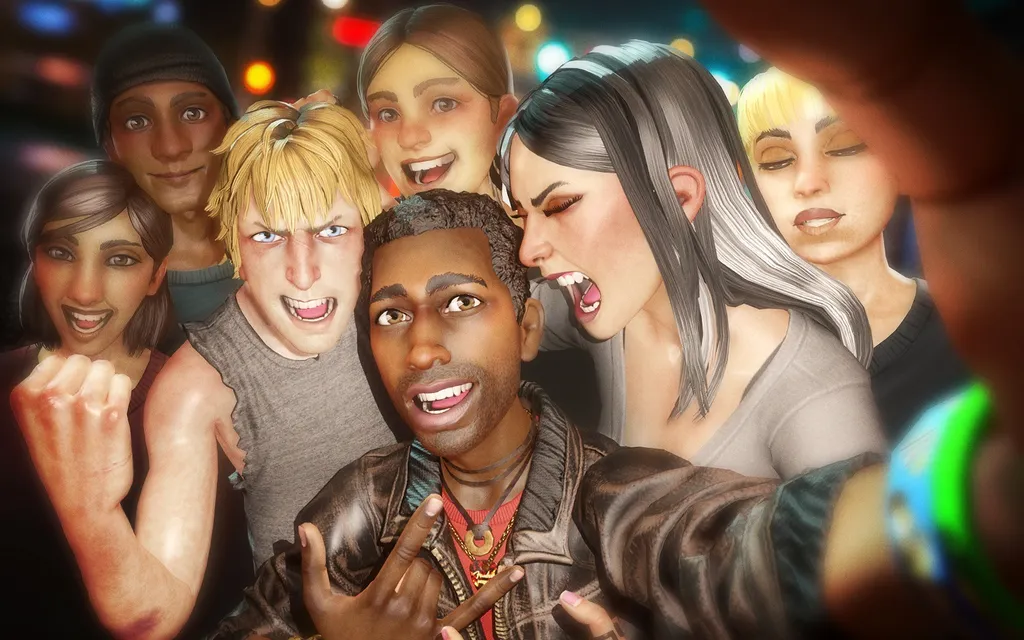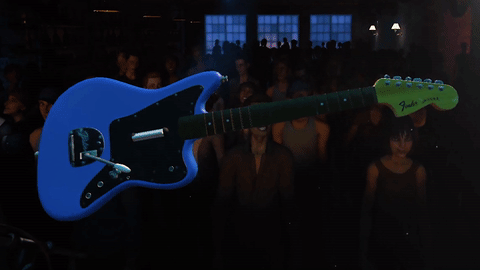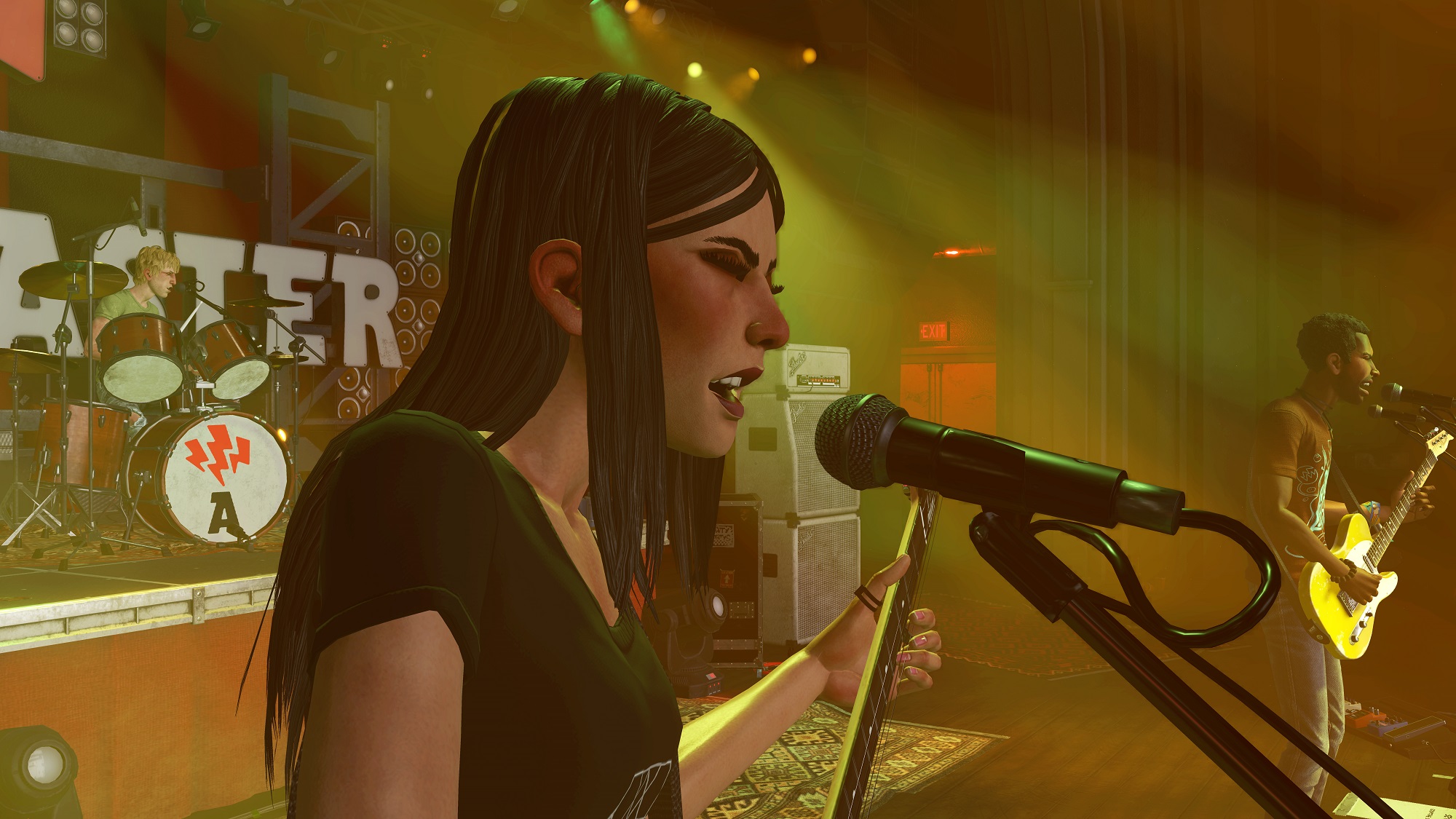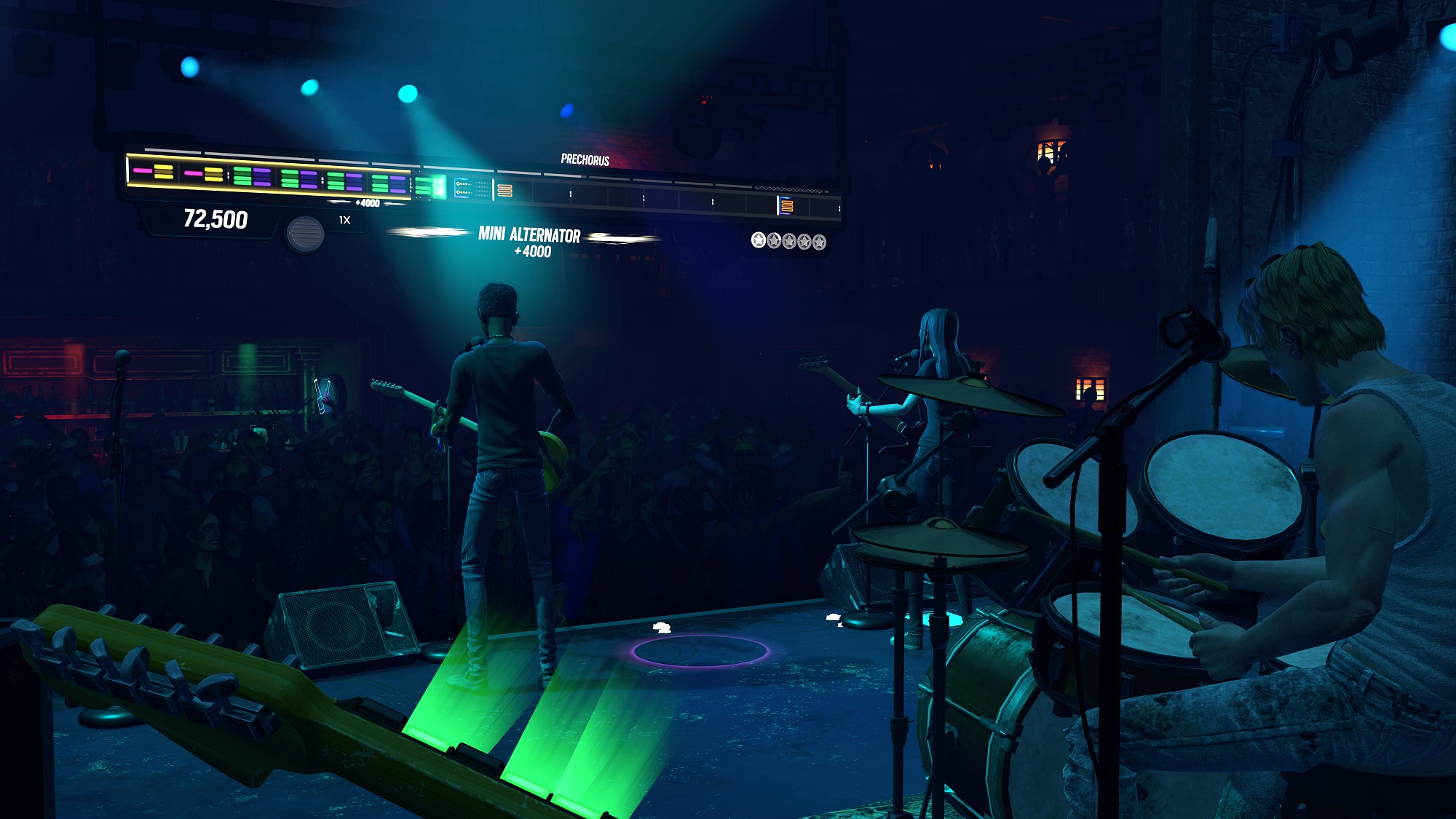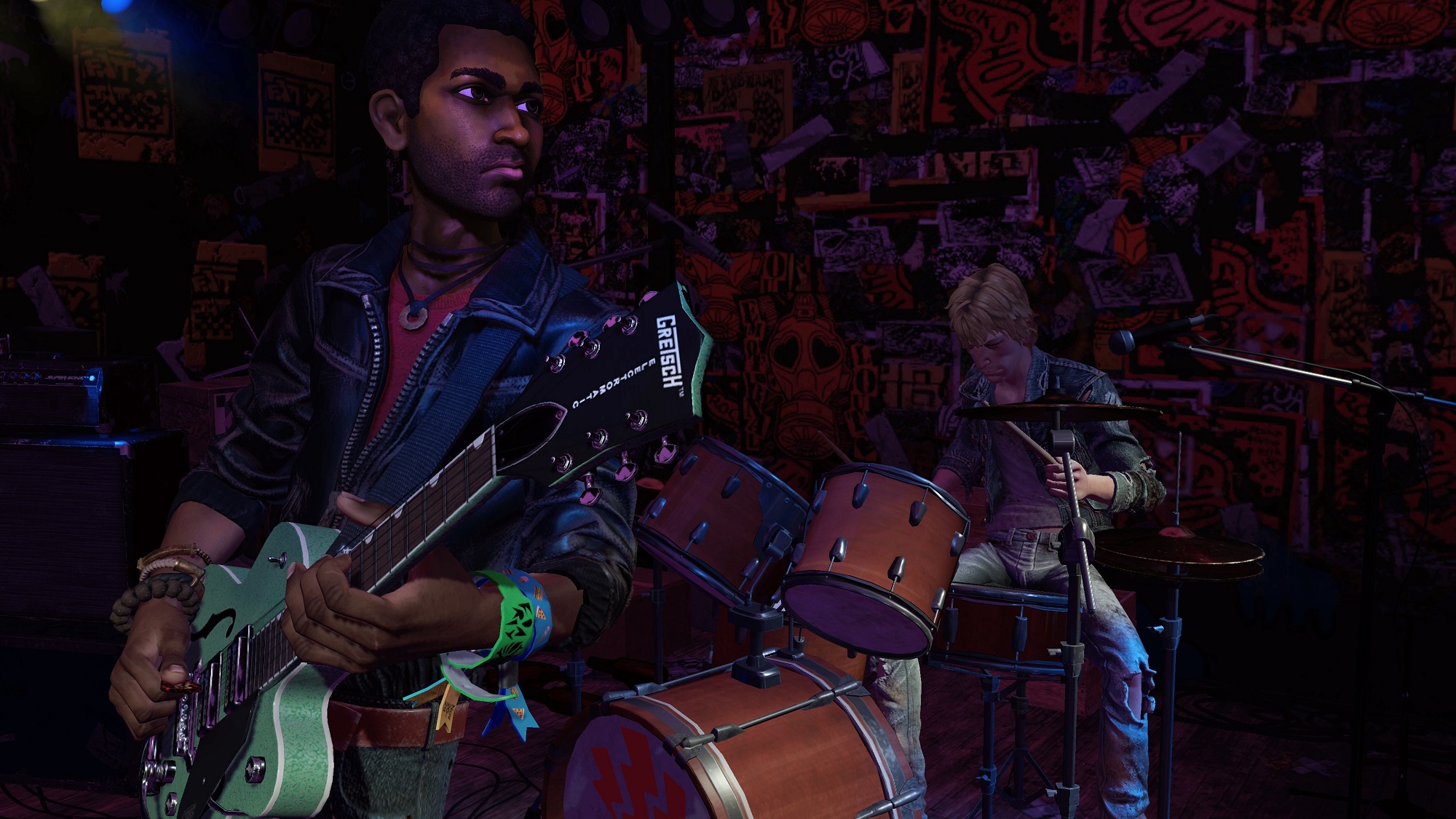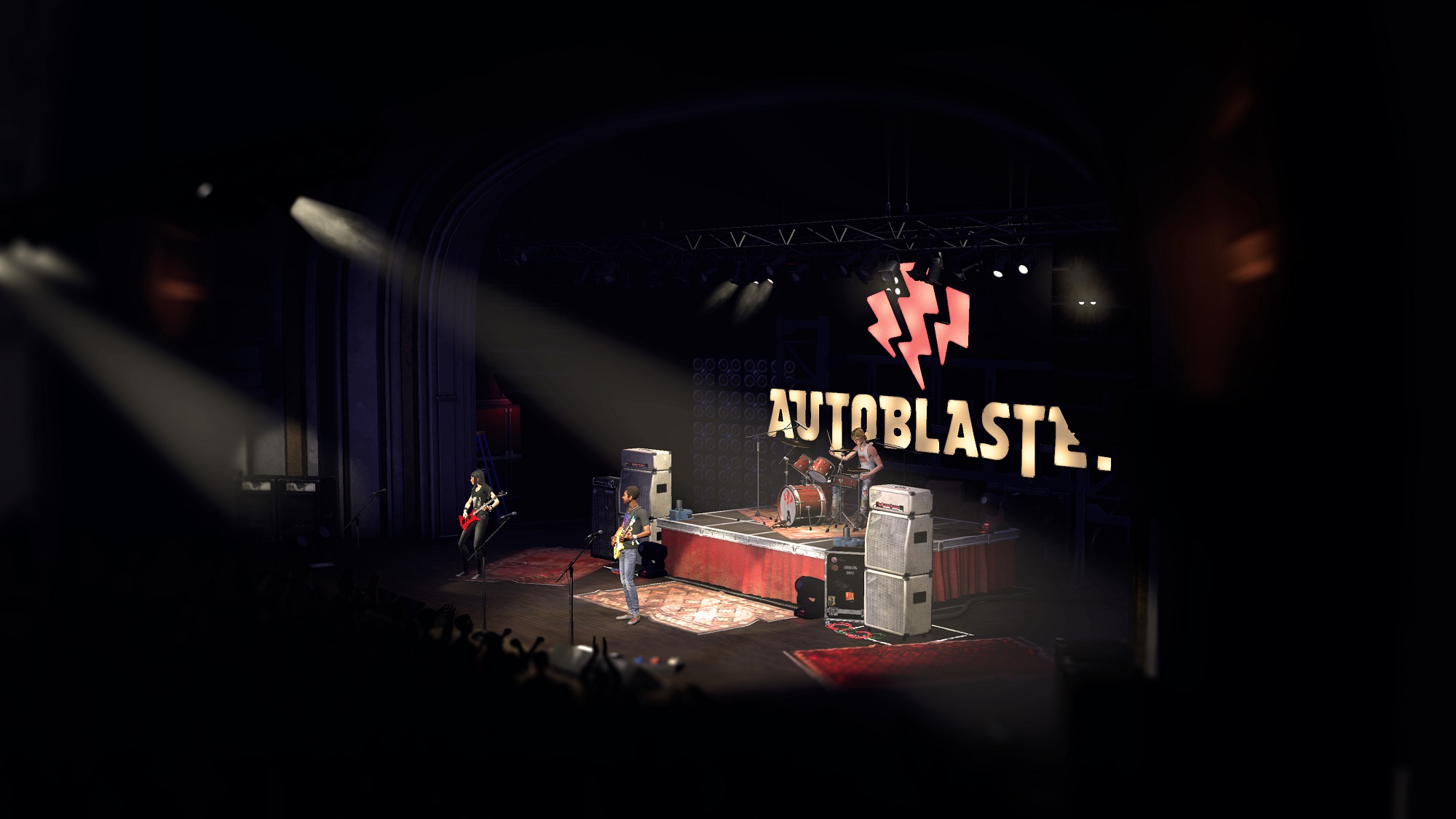I was apprehensive about the premise behind Rock Band VR. As someone that has played every entry in the Guitar Hero and Rock Band franchises — as well as lots of DLC — it felt strange to me when I learned Harmonix would shake up the fundamental formula that makes Rock Band tick. Ever since the genre rose to popularity we’ve been looking at streams of fret buttons cascading down note highways on screens telling us which buttons to press as we strum along to the music. Green, red, yellow, blue, and orange they fell, like a rainbow waterfall of sore fingers and hoarse voices.
Rock Band VR retains that traditional gameplay with its aptly titled albeit massively truncated “Classic Mode”, but much to my surprise, the real star of the show was the brand new way to play that’s been designed from the ground up with VR in mind.
At its core, the new VR mode (it’s unnamed in the game, it simply exists as the only way to play unless you specifically pick a song under “Classic Mode”) looks like a glorified freestyle session at first. If you watch someone play this way they probably won’t look at the Song Map a whole lot and may appear to just be goofing off. But in reality, it’s much more complex than that.
At the root of what makes this new mode operate is chord progression. Anyone that’s familiar with how playing an actual guitar works will probably recognize that term, but real guitar experience isn’t necessary. You can get an idea for what I mean in the GIF below:
There are seven different chords you can play, each with a different sound, and you have to play them to the beat of the song as it’s shown on the Song Map above the audience. With each section break you’re meant to switch chords and mix them together into various combos. Sometimes it will offer suggested chords for bonus points, but you’re never required to play anything in particular. Theoretically you could play the same one or two chords over and over through the whole song and you wouldn’t really “fail” in the traditional sense, but it’d be incredibly boring and dumb.
The system is made even more intricate when you’re asked to not only rack up chord combos (such as “The Alternator” which is just oscillating between two chords at each section break) but also sliding up and down the neck of the guitar at each section, which the game refers to as chord follows.
The result is that feeling out the song and knowing the rhythm ends up being more important than just staring at the Song Map. The majority of a track won’t show you which chords to play so you’ll have to find your own rhythm and mix up combos and chord follows that feel good to you. Harmonix likes to compare Classic Mode to recording a studio album since it’s full of specific notes and precision that are the same every time, whereas this new VR mode is much like playing a live show with creative freedom and variation.
Beyond the clever twisting of the traditional Rock Band formula, playing in VR inherently has its own advantages as well. You really feel like part of the band as fellow members look at you and talk to you directly before, during, and after shows. You start each set by looking at the drummer and giving him a nod. You can bang on cymbals with the neck of your guitar and even speak into the microphone or teleport around the stage. It’s the most immersive and transportive Rock Band experience ever, hands down.
Gameplay mechanics are built around this new first-person perspective as well. Once you activate overdrive by lifting your guitar upright, you can sustain it longer and get bonus points for doing things like jumping up and down, banging your head, swinging the guitar rhythmically side to side, and other similar rock star moves.
Playing songs like Bon Jovi’s “Livin’ on a Prayer”, the Foo Fighters’ “Everlong”, and Blink 182’s “Bored to Death” reminded me of what it felt like to dream about becoming a rock star in my bedroom a decade ago. It hearkened back to what it was like to jam away on an air guitar, eyes closed, biting my lip, while no one was watching, except this time I could look down and see a guitar in my hands tracked to my actual plastic guitar’s movements.
That feeling that you’re actually holding a guitar, playing in front of people, rocking out to your favorite songs, can’t be overstated.
But unfortunately the fame and adrenaline is short lived. The core “Story Mode” is only a collection of set lists at different venues with very light storytelling moments throughout. I started to appreciate and look forward to the minor moments of exposition with my band mates, but it never evolved beyond that. You’re always playing the guitarist (with no multiplayer or alternate position options) and you’re always part of the same band: Autoblaster. I was yearning for more customization options (like different guitar skins, more band mates, or home pad tweaks).
Beyond that, there is a “Quick Play” that allows you to play any song in the standard VR mode, create a custom set list, or play tracks in Classic Mode. Naturally, Classic Mode was appealing to me at first and it’s still satisfying to try tracks that have never been in a Rock Band game before (like the Oasis classic “Champagne Supernova”) but it comes at a huge cost.
You see, when you’re playing a song in Classic Mode, everything is stripped away around you. There’s no band behind the note highway, no crowd to watch as they cheer you on, and no venue to play at. You’re just standing in a dark black void with an enormous stream of colored buttons flying at your face. It feels like a huge and lonely missed opportunity. How can it be considered Rock Band if I’m standing by myself?
The learning curve for the new VR mode is quite high as well, as I had to play each of the two tutorial sessions twice to pick up on everything. My wife even got frustrated and returned to Classic Mode after about 5 minutes. With such a strong and varied set list of 60 tracks, it’s a shame that Classic Mode is only a trimmed down and truncated version of its former glory. Clearly the game is designed with a new audience in mind entirely — which isn’t necessarily bad since the new gameplay is fun once you understand it — but it could have been even better and more varied.
The lack of additional instrument support is baffling as well. The guitar I used was actually a PS4 bluetooth guitar since there isn’t a PC-based variant to choose from. I’d loved to have had support for a bassist by my side, even if outside of guitar, or a drummer, or at the very least someone to pick up a microphone and sing along with my sick riffs. But alas, there is no band in this Rock Band as it’s a purely solo guitar affair.
Rock Band VR is the biggest evolution the franchise has ever seen. The inclusion of the keyboard in Rock Band 3 was interesting and bringing a full compliment of plastic instruments to living rooms around the world with the original was revolutionary for a generation, but now this latest entry truly makes you feel like the star of your very own group. The Classic Mode is merely a shell of its former self, but the new VR features establish a more immersive way of playing the game than ever before. It’s lacking in a few areas, but the core of it all is too fun to ignore.
Rock Band VR releases March 23rd, 2017 exclusively for Oculus Rift with Touch. The game requires a modern Rock Band controller and it can be purchased either as a bundle or as an individual piece of software if you already have a compatible guitar controller. You can find out more information about the game’s features and compatibility on the official website. Read our Game Review Guidelines for more information on how we arrived at this score.

